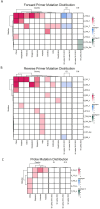This is a preprint.
Simultaneous co-circulation of two genotypes of dengue virus serotype 3 causing a large outbreak in Sri Lanka in year 2023
- PMID: 38766092
- PMCID: PMC11100923
- DOI: 10.1101/2024.05.09.24307112
Simultaneous co-circulation of two genotypes of dengue virus serotype 3 causing a large outbreak in Sri Lanka in year 2023
Update in
-
Simultaneous Cocirculation of 2 Genotypes of Dengue Virus Serotype 3 Causing a Large Outbreak in Sri Lanka in 2023.J Infect Dis. 2025 Apr 15;231(4):1041-1048. doi: 10.1093/infdis/jiae474. J Infect Dis. 2025. PMID: 39387651 Free PMC article.
Abstract
As many other countries, Sri Lanka experienced a marked rise in the number of dengue cases in 2023, with an unusual pattern of disease epidemiology. This rise coincided with the emergence of dengue virus (DENV) serotype 3 in Sri Lanka as the predominant serotype after 2009. Interestingly, a discrepancy between NS1 rapid antigen test positivity and quantitative real time PCR positivity was observed, with 50% of NS1 positive samples being negative by molecular diagnostics. Following sequencing of the DENV-3 strains in 2023, we identified two DENV-3 genotypes (I and III) co-circulating. While DENV-3 genotype III was detected by the modified CDC DENV-3 primers, genotype I evaded detection due to key mutations at forward and reverse primer binding sites. The co-circulation of multiple genotypes associated with an increase in cases highlights the importance of continuous surveillance of DENVs to identify mutations resulting in non-detection by diagnostics and differences in virulence.
Keywords: CDC PCR primers; Dengue; genotype I; genotype III; molecular epidemiology; mutations; sequencing; serotype 3.
Figures





References
-
- Organization WH. Dengue: WHO Health Emergency Appeal 2024. In: Organization WH, editor.: World Health Organization; 2024.
-
- Organization WH. Ten threats to global health in 2019. 2019. [cited 2019; Available from: https://www.who.int/emergencies/ten-threats-to-global-health-in-2019
-
- Ariyaratne D GL, Jayadas TTP, Kuruppu H, Kodituwakku L, Jeewandara C, Panniahetti N, Dheerasinghe A, Samaraweera S, Ogg G.S, Malavige G.N. Epidemiological and virological factors determining dengue transmission in Sri Lanka during the COVID-19 pandemic. PLOS Glob Public Health. 2022;2(8):e0000399. - PMC - PubMed
Publication types
Grants and funding
LinkOut - more resources
Full Text Sources
Research Materials
